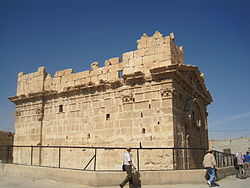Al-Dumayr
Dumeir
ضمير Dumayr | |
|---|---|
 Temple of Zeus Hypsistos, Dumeir | |
| Coordinates:33°38′31″N36°41′34″E/ 33.64194°N 36.69278°E | |
| Country | |
| Governorate | Rif Dimashq |
| District | Douma |
| Subdistrict | al-Dumayr |
| Elevation | 675 m (2,215 ft) |
| Population (2004) | |
| • Total | 24,223 |
| Time zone | UTC+3(EET) |
| • Summer (DST) | UTC+2(EEST) |
Dumeir,alsoDumair,DamirandDumayr(Arabic:الضمير) is a city located 45 kilometers north-east ofDamascus,Syria.
Archaeology
[edit]An altar dedicated to the Semitic deity,Baalshaminin 94 CE, now in theInstitut du Monde Arabein Paris, indicates that aNabateanreligious building previously stood on the site.
There is a reference to a building in a lawsuit in 216, however in 245 CE, in the reign of theRoman EmperorPhilip the Arab,the RomanTemple of Dumeir,located in the center of the old town, was dedicated toZeus HypsistosThe shape is highly unusual, and construction may have commenced as a public fountain or staging post, but in its final form it is clearly a temple.
It was fortified in the Arab period, the arch on the rear wall being filled in with stones and defensive devices. The temple has been restored as the result of much research and reconstruction work.[1]
TheGhassanidphylarch(tribal king)al-Mundhir III ibn al-Harithbuilt a tower at Dumayr. A Greek inscription engraved by al-Mundhir credits himself for its construction and thanks God andSt. Julian.[2]A monastery associated with the Ghassanids called Dayr al-Matirun, likely an Arabicized version of the Greekmartyrion,existed about 3 kilometers (1.9 mi) east of Dumayr.[3]
Facilities
[edit]A cemetery was built in 1960 for the French casualties of WWI and WWII in Al-Dumayr.[4]TheSyrian Arab Air ForceAl-Dumayr Military Airportis also located in Al-Dumayr.
See also
[edit]- Al-Dumayr offensive (April 2016)
- Desert castles- the Al-Dumayrqasrpossibly dates to the Byzantine period, maybe built by the Ghassanids, but might be Umayyad as well[5][6][7]
References
[edit]- ^Burns, Ross (2009).The Monuments of Syria(3rd ed.). I. B. Taurus. pp. 147–148.
- ^Shahid 2002, pp.131,133,206
- ^Shahid 2002, pp.189–190
- ^"Le cimetière militaire de Dmeir, en Syrie".souvenirfrancais-issy(in French).Archivedfrom the original on 2022-05-22.Retrieved2020-04-18.
- ^Lenoir, Maurice (1999)."Dumayr, faux camp romain, vraie résidence palatiale"(PDF).Syria(in French).76.Beirut:Institut français du Proche-Orient:227–236 [233–234].doi:10.3406/syria.1999.7614.Retrieved8 March2021.[permanent dead link]
- ^Genequand, Denis (2004)."Al-Bakhra (Avatha), from the Tetrarchic Fort to the Umayyad Castle".Levant.36(36).Council for British Research in the Levant:225–242 [237–38].doi:10.1179/lev.2004.36.1.225.S2CID162256544.Retrieved8 March2021.
The palatial residence in Dumayr, of which the date and history are still uncertain (Byzantine or early Islamic)
- ^Hoyland, Robert (2017). Nehmé, Laïla; Al-Jallad, Ahmad (eds.).Two New Arabic Inscriptions: Arabian Castles and Christianity in the Umayyad Period.Studies in Semitic Languages and Linguistics. BRILL. p. 327-337 [330].ISBN9789004357617.Retrieved8 March2021.
It is difficult to make a convincing case for a Ghassanid owner, since we have no residential buildings that can be confidently ascribed to a Ghassanid or any Arab tribal leader from the pre-Islamic period, whereas we have numerous examples of Umayyad palatial residences (Genequand 2003). [Referring to the "rather fine castle" at Khirbat al-Bayda', modern southern Syria]
{{cite book}}:|work=ignored (help)
Bibliography
[edit]- Shahid, Irfan(2002).Byzantium and the Arabs, Volume 2, Part 1.Washington, D. C.: Dumbarton Oaks Research Library and Collection.




